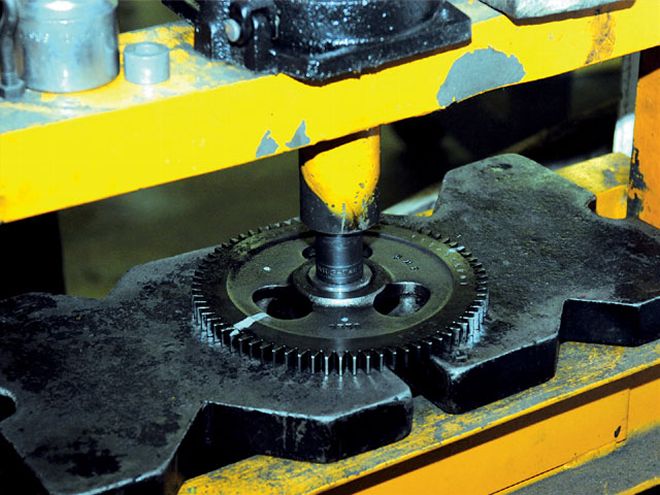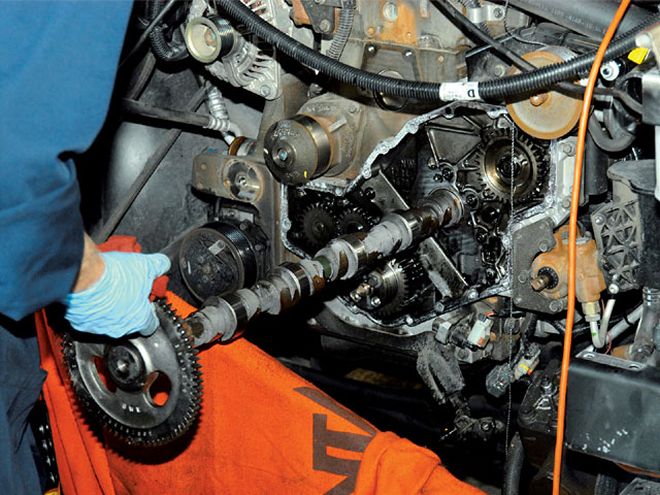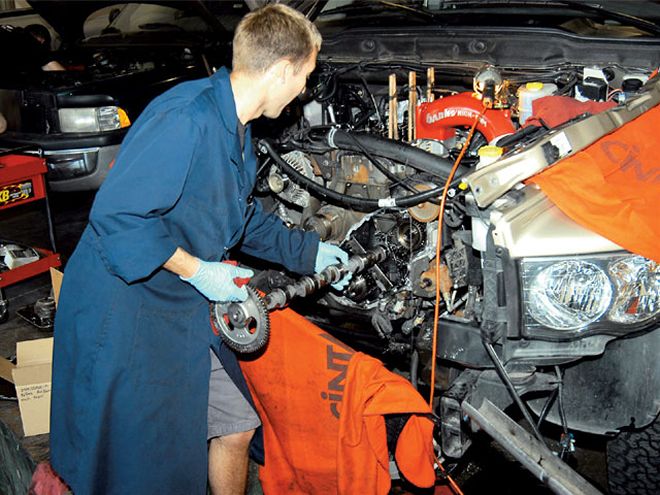
| cummins Camshaft Swap camshaft Removal
With diesel fuel prices at an all-time high, we've been testing various products in an effort to find ways to increase the efficiency of the diesel engine. Our hope is to find results that will offer better fuel economy, and if possible, increase torque. Most of the products we have tried up to this point have offered some positive results, and some products have worked better than others. Many of the products available are not by any means light on the pocketbook, and some are beyond "plug and play" installations, requiring professional, or at the very least, a skilled installation, which can add to the cost. If anything, we have reinforced the old adage "If it seems too good to be true, it probably is."
Recently, we had the opportunity to spend some time with Piers Harry, formally of Piers Diesel Research. He mentioned that before he left PDR he had developed a camshaft grind for the common rail '03-and-later Cummins-powered Dodge trucks, which resulted in a fuel economy increase of about 2 mpg and maybe picked up a horsepower or two. We know what you're thinking. If obtaining better fuel economy can be found from a different cam grind, why didn't Cummins do it? The answer is that the Cummins Engine Company has to abide by federal emissions guidelines, and you, the end user, may not.
After we had the new cam broken in, we took a road test to see how it felt. Right off, we noted the sound was more like the older 12-valve Cummins; not as loud, but there was a new pleasant tonal quality. Swapping the camshaft in a Cummins engine is not what we'd call easy. The process developed by Cummins borders between genius and insanity. For those not familiar, it involves slotted semi-circular metal trays, wooden dowels, magnets, strings, and rubber bands. This is not your typical backyard shade tree installation. As if that weren't enough to discourage most, the entire front of the truck has to be dissembled (including taking a Sawzall to the radiator support) to permit access to remove and install the new cam.
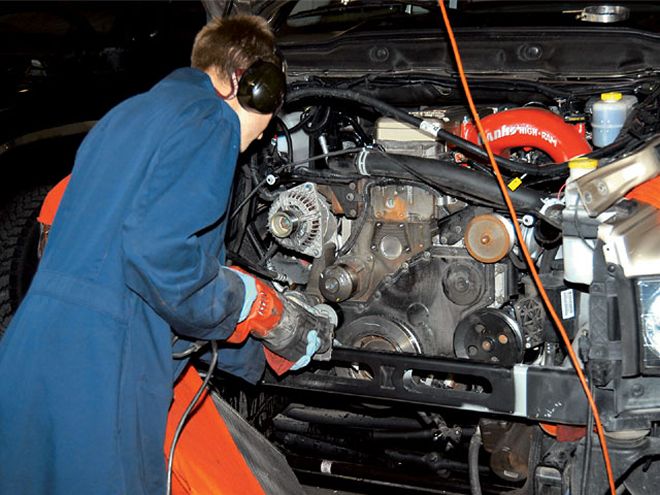
| cummins Camshaft Swap front End Disassembly
In order to meet the '03 nitrogen oxides standards, combustion cylinder pressures had to be lowered. One way to accomplish this goal is to retard injection timing, thus reducing cylinder pressure and reducing nitrogen oxides (one of the design functions of the OEM camshaft). The Catch 22 is that it takes more fuel to operate in this manner. But what if you could convert to a camshaft that was fuel economy biased instead of emissions biased? We wanted to find out.
Fuel Economy TestingWhat will all this do for our fuel economy? In an '05 Quad Cab 4x4 with the G56 six-speed manual transmission and 3.73 gears, we have established the following: our unloaded truck fuel economy averaged 15.8 mpg and towing averaged 9.4 mpg.
Keep in mind that our test truck weighs 7,240 pounds even when it's unloaded. Towing was accomplished by pulling a 24-foot Haulmark enclosed car hauler. The gross combined weight of the truck and trailer is 22,800 pounds. We logged approximately 9,800 miles empty, and the balance of the first 15,000 miles towing established our baseline.
First, we ran the short track empty (approximately 150 miles), then the short track towing, followed by the long track empty (approximately 700 miles), and the long track towing.
During that time, we found that driving our Cummins-powered Ram with the PDR cam was a pleasure. We saw that there was an average fuel economy increase of approximately 2.1 mpg across the board. The results remained consistent towing or empty, city or highway.
PDR has two options for the new cam: one is an all-new camshaft made from a billet cam blank, the other is a regrind of the OEM camshaft. Each offers its own benefits. The billet cam is purchased outright, and the regrind requires a core deposit ($447). The billet cam has the additional lobe required to drive a mechanical fuel-injection pump if you were inclined to convert a 24-valve engine to a P7100 injection pump.
The timing gear is a heat/press fitting and a hydraulic press is required for removal of the gear, which was reused on the new camshaft.
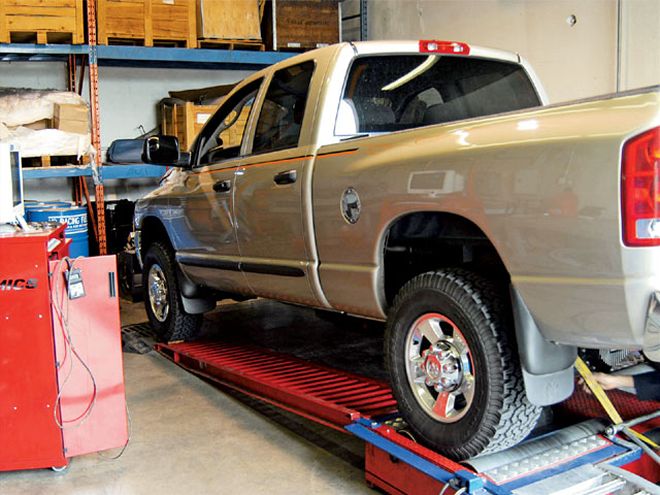
| cummins Camshaft Swap dyno Tune
The Power TestingSince the test truck had the Banks Big Hoss Bundle installed with a Banks PowerPDA, we decided to make a few dyno runs with the stock camshaft in the stock and in the Speed-Loader settings. We made three runs in each setting, making sure our records were consistent. The stock setting resulted in 296 peak horsepower at 2,800 rpm and 568 lb-ft of torque at 2,660 rpm. The Banks Speed-Loader provided a very respectable 383 peak horsepower at 2,500 rpm and 823 lb-ft of torque at 2,447 rpm. Exhaust gas temperatures never climbed above 1,197 degrees in either case, and our maximum boost was 31 psi for the stock run and 38 psi for Speed-Loader.
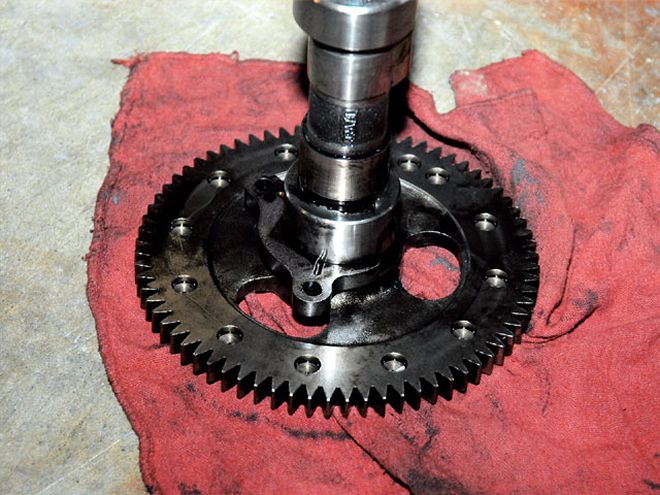
| The timing gear is a heat/press fitting and a hydraulic press is required for removal of the gear, which was reused on the new camshaft.
Then we repeated the dyno runs with the new PDR camshaft installed. With the PowerPDA in the stock setting, the power curves were all but mirror images of each previous run. The exception is we picked up 3 hp at 2,800 rpm (299 hp) and torque remained at 568 lb-ft. Boost pressure increased 4 psi (to 35 psi) and EGT dropped 17 degrees (to 1,180 degrees), a negligible change. In the Speed-Loader setting, the horsepower climbed from 383 hp to 393 hp at 2,500 rpm and the torque increased from 823 lb-ft to 861 lb-ft at 2,022 rpm. The original baseline peak torque occurred at 2,400 rpm. Now the peak torque had occurred almost 400 rpm lower. In fact, we noted increased torque output starting at 1,800 rpm and continuing all the way to 3,400 rpm. It appears the cam has not only improved our horsepower and torque numbers but it has caused the curve to come on stronger at lower engine speeds.
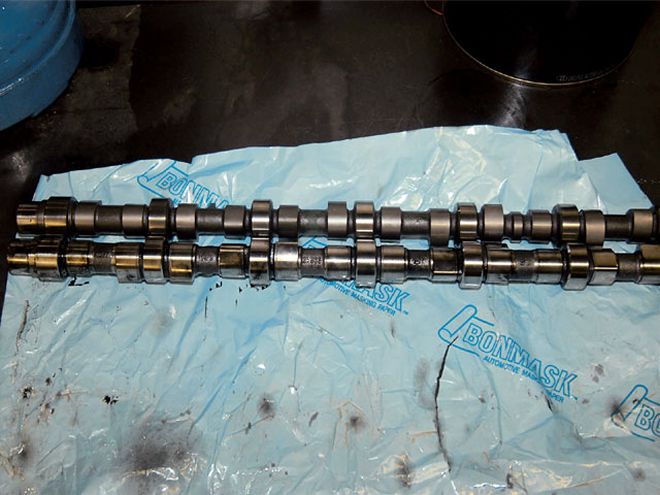
| cummins Camshaft Swap cams
PDR has two options for the new cam: one is an all-new camshaft made from a billet cam blank, the other is a regrind of the OEM camshaft. Each offers its own benefits. The billet cam is purchased outright, and the regrind requires a core deposit ($447). The billet cam has the additional lobe required to drive a mechanical fuel-injection pump if you were inclined to convert a 24-valve engine to a P7100 injection pump.
Can The Overhead Console Be Trusted?If there is one item that proved itself consistently inconsistent and inaccurate it is the overhead console fuel economy meter. The readings have been as much as 2.5 mpg under the actual mileage, and at times, over the actual by more than 4.7 mpg. There will be those who will want to argue that they have filled their tanks to the top and checked the calculations. Unless you have an exact method of measuring the fuel consumed (via weight or fuel flow meters) over a given distance, it might as well be a shot in the dark. You can quote the console meter over a tailgate chat with your friends if it makes you feel better, but in truth it's, at best, a general "kind of an average." Which also brings up the distance to empty function. Again, at best, a "kind of a guideline" not to be taken too seriously if you plan to arrive at your destination on time.
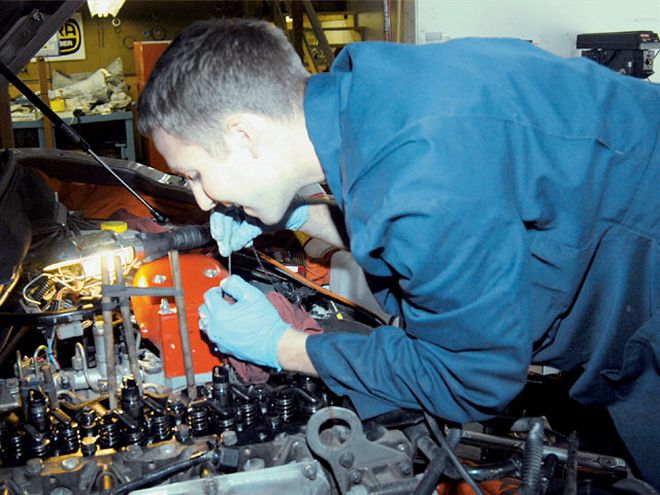
| cummins Camshaft Swap comparison
We discussed the proprietary grind with 26-year veteran cam grinder, Jeff Colt, at Colt Cams. PDR offers cams for first gen, second gen and third gen Cummins-powered Rams. The regrind cam has the advantage of slightly wider lifter lobes and a little more material around the diameter of the shaft where the timing gear would press on. The diameter of the regrind measures approximately 1.44 inches and the billet measures approximately 1.38 inches. The new billet cam comes with new lifters, while the regrind is supplied with reground lifters.
Is The Camshaft Swap Really Worth It?* MSRP for the billet cam: $650
* MSRP for the regrind cam: $650
* Lifters (12-valve and 24-valve): $69.00; common rail: $57
* PDR charges 12 hours labor at $75.00 per hour
* PDR also charges 5 percent of the total labor for shop supplies (gaskets, silicon, and so on)Given the improvement in overall drivability and the bonus of the slight horsepower and torque gain, the PDR camshaft merits installation in trucks that are used to tow. However, if you are looking for a financial method to justify your purchase, it would look something like this: using the MSRP ($650 cam + $57 lifters + $900 labor + $45 shop supplies = $1,652). Calculating a fuel economy increase of 2.0 mpg and using $3 per gallon for the cost of fuel, it would take approximately 29,736 miles to see a return on your investment.
Can The Overhead Console Be Trusted?If there is one item that proved itself consistently inconsistent and inaccurate it is the overhead console fuel economy meter. The readings have been as much as 2.5 mpg under the actual mileage, and at times, over the actual by more than 4.7 mpg. There will be those who will want to argue that they have filled their tanks to the top and checked the calculations. Unless you have an exact method of measuring the fuel consumed (via weight or fuel flow meters) over a given distance, it might as well be a shot in the dark. You can quote the console meter over a tailgate chat with your friends if it makes you feel better, but in truth it's, at best, a general "kind of an average." Which also brings up the distance to empty function. Again, at best, a "kind of a guideline" not to be taken too seriously if you plan to arrive at your destination on time.
 | cummins Camshaft Swap camshaft Removal
With diesel fuel prices at an all-time high, we've been testing various products in an effort to find ways to increase the efficiency of the diesel engine. Our hope is to find results that will offer better fuel economy, and if possible, increase torque. Most of the products we have tried up to this point have offered some positive results, and some products have worked better than others. Many of the products available are not by any means light on the pocketbook, and some are beyond "plug and play" installations, requiring professional, or at the very least, a skilled installation, which can add to the cost. If anything, we have reinforced the old adage "If it seems too good to be true, it probably is."
Recently, we had the opportunity to spend some time with Piers Harry, formally of Piers Diesel Research. He mentioned that before he left PDR he had developed a camshaft grind for the common rail '03-and-later Cummins-powered Dodge trucks, which resulted in a fuel economy increase of about 2 mpg and maybe picked up a horsepower or two. We know what you're thinking. If obtaining better fuel economy can be found from a different cam grind, why didn't Cummins do it? The answer is that the Cummins Engine Company has to abide by federal emissions guidelines, and you, the end user, may not.
After we had the new cam broken in, we took a road test to see how it felt. Right off, we noted the sound was more like the older 12-valve Cummins; not as loud, but there was a new pleasant tonal quality. Swapping the camshaft in a Cummins engine is not what we'd call easy. The process developed by Cummins borders between genius and insanity. For those not familiar, it involves slotted semi-circular metal trays, wooden dowels, magnets, strings, and rubber bands. This is not your typical backyard shade tree installation. As if that weren't enough to discourage most, the entire front of the truck has to be dissembled (including taking a Sawzall to the radiator support) to permit access to remove and install the new cam.
| cummins Camshaft Swap camshaft Removal
With diesel fuel prices at an all-time high, we've been testing various products in an effort to find ways to increase the efficiency of the diesel engine. Our hope is to find results that will offer better fuel economy, and if possible, increase torque. Most of the products we have tried up to this point have offered some positive results, and some products have worked better than others. Many of the products available are not by any means light on the pocketbook, and some are beyond "plug and play" installations, requiring professional, or at the very least, a skilled installation, which can add to the cost. If anything, we have reinforced the old adage "If it seems too good to be true, it probably is."
Recently, we had the opportunity to spend some time with Piers Harry, formally of Piers Diesel Research. He mentioned that before he left PDR he had developed a camshaft grind for the common rail '03-and-later Cummins-powered Dodge trucks, which resulted in a fuel economy increase of about 2 mpg and maybe picked up a horsepower or two. We know what you're thinking. If obtaining better fuel economy can be found from a different cam grind, why didn't Cummins do it? The answer is that the Cummins Engine Company has to abide by federal emissions guidelines, and you, the end user, may not.
After we had the new cam broken in, we took a road test to see how it felt. Right off, we noted the sound was more like the older 12-valve Cummins; not as loud, but there was a new pleasant tonal quality. Swapping the camshaft in a Cummins engine is not what we'd call easy. The process developed by Cummins borders between genius and insanity. For those not familiar, it involves slotted semi-circular metal trays, wooden dowels, magnets, strings, and rubber bands. This is not your typical backyard shade tree installation. As if that weren't enough to discourage most, the entire front of the truck has to be dissembled (including taking a Sawzall to the radiator support) to permit access to remove and install the new cam.
 | cummins Camshaft Swap front End Disassembly
In order to meet the '03 nitrogen oxides standards, combustion cylinder pressures had to be lowered. One way to accomplish this goal is to retard injection timing, thus reducing cylinder pressure and reducing nitrogen oxides (one of the design functions of the OEM camshaft). The Catch 22 is that it takes more fuel to operate in this manner. But what if you could convert to a camshaft that was fuel economy biased instead of emissions biased? We wanted to find out.
| cummins Camshaft Swap front End Disassembly
In order to meet the '03 nitrogen oxides standards, combustion cylinder pressures had to be lowered. One way to accomplish this goal is to retard injection timing, thus reducing cylinder pressure and reducing nitrogen oxides (one of the design functions of the OEM camshaft). The Catch 22 is that it takes more fuel to operate in this manner. But what if you could convert to a camshaft that was fuel economy biased instead of emissions biased? We wanted to find out.
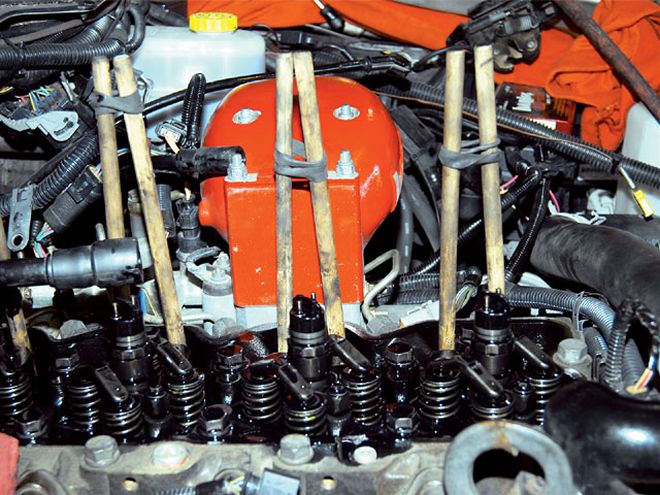
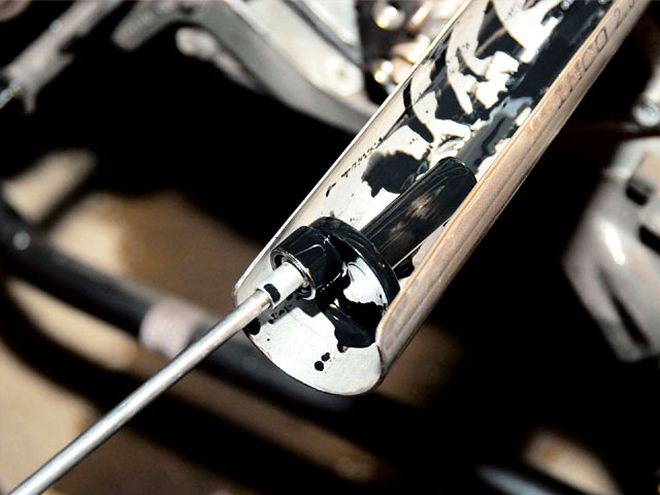
 | cummins Camshaft Swap dyno Tune
The Power Testing
| cummins Camshaft Swap dyno Tune
The Power Testing | The timing gear is a heat/press fitting and a hydraulic press is required for removal of the gear, which was reused on the new camshaft.
Then we repeated the dyno runs with the new PDR camshaft installed. With the PowerPDA in the stock setting, the power curves were all but mirror images of each previous run. The exception is we picked up 3 hp at 2,800 rpm (299 hp) and torque remained at 568 lb-ft. Boost pressure increased 4 psi (to 35 psi) and EGT dropped 17 degrees (to 1,180 degrees), a negligible change. In the Speed-Loader setting, the horsepower climbed from 383 hp to 393 hp at 2,500 rpm and the torque increased from 823 lb-ft to 861 lb-ft at 2,022 rpm. The original baseline peak torque occurred at 2,400 rpm. Now the peak torque had occurred almost 400 rpm lower. In fact, we noted increased torque output starting at 1,800 rpm and continuing all the way to 3,400 rpm. It appears the cam has not only improved our horsepower and torque numbers but it has caused the curve to come on stronger at lower engine speeds.
| The timing gear is a heat/press fitting and a hydraulic press is required for removal of the gear, which was reused on the new camshaft.
Then we repeated the dyno runs with the new PDR camshaft installed. With the PowerPDA in the stock setting, the power curves were all but mirror images of each previous run. The exception is we picked up 3 hp at 2,800 rpm (299 hp) and torque remained at 568 lb-ft. Boost pressure increased 4 psi (to 35 psi) and EGT dropped 17 degrees (to 1,180 degrees), a negligible change. In the Speed-Loader setting, the horsepower climbed from 383 hp to 393 hp at 2,500 rpm and the torque increased from 823 lb-ft to 861 lb-ft at 2,022 rpm. The original baseline peak torque occurred at 2,400 rpm. Now the peak torque had occurred almost 400 rpm lower. In fact, we noted increased torque output starting at 1,800 rpm and continuing all the way to 3,400 rpm. It appears the cam has not only improved our horsepower and torque numbers but it has caused the curve to come on stronger at lower engine speeds.
 | cummins Camshaft Swap cams
PDR has two options for the new cam: one is an all-new camshaft made from a billet cam blank, the other is a regrind of the OEM camshaft. Each offers its own benefits. The billet cam is purchased outright, and the regrind requires a core deposit ($447). The billet cam has the additional lobe required to drive a mechanical fuel-injection pump if you were inclined to convert a 24-valve engine to a P7100 injection pump.
Can The Overhead Console Be Trusted?
| cummins Camshaft Swap cams
PDR has two options for the new cam: one is an all-new camshaft made from a billet cam blank, the other is a regrind of the OEM camshaft. Each offers its own benefits. The billet cam is purchased outright, and the regrind requires a core deposit ($447). The billet cam has the additional lobe required to drive a mechanical fuel-injection pump if you were inclined to convert a 24-valve engine to a P7100 injection pump.
Can The Overhead Console Be Trusted? | cummins Camshaft Swap comparison
We discussed the proprietary grind with 26-year veteran cam grinder, Jeff Colt, at Colt Cams. PDR offers cams for first gen, second gen and third gen Cummins-powered Rams. The regrind cam has the advantage of slightly wider lifter lobes and a little more material around the diameter of the shaft where the timing gear would press on. The diameter of the regrind measures approximately 1.44 inches and the billet measures approximately 1.38 inches. The new billet cam comes with new lifters, while the regrind is supplied with reground lifters.
Is The Camshaft Swap Really Worth It?
| cummins Camshaft Swap comparison
We discussed the proprietary grind with 26-year veteran cam grinder, Jeff Colt, at Colt Cams. PDR offers cams for first gen, second gen and third gen Cummins-powered Rams. The regrind cam has the advantage of slightly wider lifter lobes and a little more material around the diameter of the shaft where the timing gear would press on. The diameter of the regrind measures approximately 1.44 inches and the billet measures approximately 1.38 inches. The new billet cam comes with new lifters, while the regrind is supplied with reground lifters.
Is The Camshaft Swap Really Worth It?